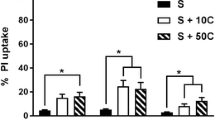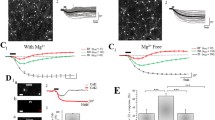Abstract
The effects of mitochondrial respiratory chain inhibitors and the excitotoxinN-methyl-D-aspartate (NMDA) on cell death in hippocampal subfields CA1 and CA3 were examined in hippocampal organotypic slice cultures. Slice cultures, 2–3 week old, were exposed for 1 h to either the Complex 1 inhibitors, rotenone or 1-methyl-4-phenylpyridium (MPP+), the Complex II inhibitor 3-nitropropionic acid (3-NP), or the excitotoxin NMDA. Cell death was examined 24 and 48 h following treatment, by measuring propidium iodide (PI) fluorescence. Treatment with 1 μM rotenone caused greater cell death in hippocampal subfield CA1 than CA3. Exposure of hippocampal slice cultures to 10 μM rotenone, to MPP+ or to NMDA resulted in damage to both CA1 and CA3 subfields. 3-NP produced little damage in either subfield. The data suggest that mitochondrial complex I inhibition can produce selective cell damage in hippocampus and in this regard is similar to that observed following hypoxia/ischemia.
Similar content being viewed by others
References
Beal MF (2001) Mitochondria and oxidative damage in amyotrophic lateral sclerosis.Funct. Neurol. 16, Suppl. 4, 161–169.
Bergold PJ and P Casaccia-Bonnefil (1997) Preparation of organotypic hippocampal slice cultures using the membrane filier method.Methods Mol. Biol. 72, 15–22.
Betarbet R, TB Sherer, G Mackenzie, M Garcia-Osuna, W Panov and JT Greenamyre (2000) Chronic systemic pesticide exposure reproduces features of Parkinson's disease.Nat. Neurosci. 3, 1301–1306.
Betarbet R, TB Sherer and JT Greenamyre (2002) Animal models of Parkinson's disease.Bioessays 24, 308–318.
Dave KR, I Saul, R Busto, MD Ginsberg, TJ Sick and MA Perez-Pinzon (2001) Ischemic preconditioning preserves mitochondrial function after global cerebral ischemia in rat hippocampus.J. Cereb. Blood Flow Metab. 21, 1401–1410.
Eisen A and M Weber (2001) The motor cortex and amyotrophic lateral sclerosis.Muscle Nerve 24, 564–573.
Fiskum G, AN Murphy and MF Beal (1999) Mitochondria in neurodegeneration: acute ischemia and chronic neurodegenerative diseases.J. Cereb. Blood Flow Metab. 19, 351–369.
Fonck C and M Baudry (2003) Rapid reduction of ATP synthesis and lack of free radial formation by MPP+ in rat brain synaptosomes and mitochondria.Brain Res. 975, 214–221.
Frantseva MV, PL Carlen and JL Perez Velazquez (2001) Dynamies of intracellular calcium and free radical production during ischemia in pyramidal neurons.Free Radic. Biol. Med. 15, 1216–1227.
Greenamyre JT, TB Sherer, R Betarbet and AV Panov (2001) Complex I and Parkinson's diseaseIUBMB Life 52, 135–411.
Javitch JA and SH Snyder (1984) Uptake of MPP(+) by dopamine neurons explains selectivity of parkinsonism-inducing neurotoxin, MPTP.Eur. J. Pharmacol. 13, 455–456.
Kirino T (1982) Delayed neuronal death in the gerbil hippocampus following ischemia.Brain Res. 239, 57–69.
Kirino T (2000) Delayed neuronal death.Neuropathology 20 Suppl., S95-S97.
Kristensen BW, J Noraberg and J Zimmer (2001) Comparison of excitotoxic profiles of ATPA, AMPA, KA and NMDA in organotypic hippocampal slice cultures.Brain Res. 917, 21–44.
Laake JH, FM Haug, T Wieloch and OP Otrersen (1999) A simplein vitro model of ischemia based on hippocampal slice cultures and propidium iodide fluorescence.Brain Res. Brain Res. Protoc. 4, 173–184.
Langston JW, P Ballard, JW Tetrud and I Irwin (1983) Chronic Parkinsonism in humans due to a product of meperidine-analog synthesis.Science 219, 979–980.
Langston JW, I Irwin, EB Langston and LS Forno (1984) Pargyline prevents MPTP-induced parkinsonism in primates.Science 225, 1480–14822.
Langston JW, LS Forno, J Tetrud, AG Reeves, JA Kaplan and D Karluk (1999) Evidence of active nerve cell degeneration in the substantia nigra of humans years after 1-methyl-4-phenyl-1,2,3,6-tetrahydropyridine exposure.Ann. Neurol. 46, 598–605.
Leist M, C Volbracht, E Fava, P Nicotera (1998) 1-Methyl-4-phenylpyridinium induces autocrine excitotoxicity, protease activation, and neuronal apoptosis.Mol. Pharmacol. 54, 789–801.
Mitani A, S Takeyasu, H Yanase, Y Nakamura and K Kataoka (1994) Changes in intracellular Ca2+ and energy levels duringin vitro ischemia in the gerbil hippocampal slice.J. Neurochem. 62, 626–634.
Nicklas WJ, SK Youngster, MV Kindt and RE Heikkila (1987) MPTP, MPP+ and mitochondrial function,Life. Sci. 23, 721–729.
Parker Jr WD, SJ Boyson and JK Parks (1989) Abnormalities of the electron transport chain in idiopathic Parkinson's disease.Ann. Neurol. 26, 719–723.
Prendergast MA, BR Harris, S Mayer, RC Holley, JR Pauly and JM Lutleton (2001) Nicotine exposure reducesN-methyl-D-aspartate toxicity in the hippocampus: relation to distribution of the α7 nicotinic acetylcholine receptor subunit.Med. Sci. Monit. 7, 1153–1160.
Rosenthal M, ZC Feng, CN Raffin, M Harrison and TJ Sick (1995) Mitochondrial hyperoxidation signals residual intracellular dysfunction after global ischemia in rat neocortex,J. Cereb. Blood Flow Metab. 15, 655–665.
Pulsinelli WA, JB Brierley and F. Plum (1982) Temporal profile of neuronal damage in a model of transient forebrain ischemia.Ann. Neurol. 11, 491–498.
Saybasili H, M Yuksel, G Haklar and AS Yalcin (2001) Effect of mitochondrial electron transport chain inhibitors on superoxide radical generation in rat hippocampal and striatal slices.Antioxid. Redox. Signal. 3, 1099–1104.
Schapira AH, JM Cooper, D Dexter, P Jenner, JB Clark and CD Marsden (1989) Mitochondrial complex I deficiency in Parkinson's disease.Lancet 1, 1269.
Sciamanna MA, J Zinkel, AY Fabi and CP Lec (1992) Ischemic injury to rat forebrain mitochondria and cellular calcium homeostasis.Biochim. Biophys. Acta 1134, 223–232.
Sims NR and WA Pulsinelli (1987) Altered mitochondrial respiration in selectively vulnerable brain subregions following transient forebrain ischemia in the rat,J. Neurochem. 49, 1367–1374.
Sousa SC, EN Maciel, AE Vercesi and RF Castilho (2003) Ca2+-induced oxidative stress in brain mitochondria treated with the respiratory chain inhibitor rotenone.FEBS Lett. 543, 179–183.
Sugino T, K Nozaki, Y Takagi and N Hashimoto (1999) 3-Nitropropionic acid induces ischemic tolerance in gerbil hippocampusin vivo.Neurosci. Lett. 259, 9–12.
Whitehouse PJ, DL Price, AW Clark, JT Coyle and MP DeLong (1981) Alzheimer disease: evidence for selective loss of cholinergic neurons in the nucleus basalis.Ann. Neurol. 10, 122–126.
Author information
Authors and Affiliations
Corresponding author
Rights and permissions
About this article
Cite this article
Xu, G., Perez-Pinzon, M.A. & Sick, T.J. Mitochondrial complex I inhibition produces selective damage to hippocampal subfield CA1 in organotypic slice cultures. neurotox res 5, 529–537 (2003). https://doi.org/10.1007/BF03033163
Received:
Revised:
Accepted:
Issue Date:
DOI: https://doi.org/10.1007/BF03033163




